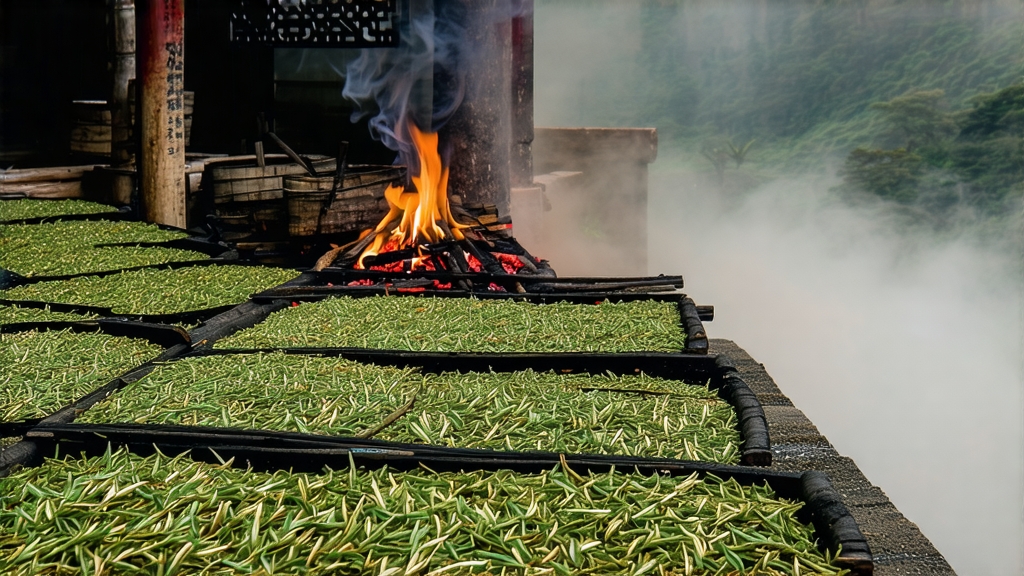
Ask most tea lovers to name a Chinese black tea and they will answer Keemun or perhaps Dian Hong; few realize that the very first black tea ever created was Lapsang Souchong, born in the cool gorges of the Wuyi Mountains in northern Fujian around the late Ming dynasty. Locals call it Zheng Shan Xiao Zhong—“small leaf from the original mountain”—and its story begins with accident, urgency, and the scent of burning pine.
Legend says that in 1646 a Qing army unit was passing through Tongmu village just as the fresh tea harvest lay spread on bamboo trays. To keep the leaves from spoiling, farmers rushed them through withering and drying over the resinous pinewood fires that warmed their huts. The next morning the leaves had turned glossy black, exuding an intoxicating aroma of smoked longan and campfire. Expecting disaster, the farmers brewed a cup; instead they tasted a sweet, mellow liquor unlike anything green or oolong had ever offered. Traders from the Dutch East India Company carried the novel tea to Europe where it became the prototype for every “black” tea that followed, giving the English language the very word “bohea” (from Wuyi) and Catherine of Braganza her daily cup that launched the British tea craze.
True Lapsang Souchong is still produced only inside the 600–1,200 m core zone of the Wuyi National Nature Reserve, a UNESCO dual World Heritage site for both culture and biodiversity. Here, a subtropical monsoon climate shrouds tea gardens in fog 240 days a year, slowing leaf growth and concentrating amino acids that translate into natural sweetness. The indigenous cultivar is Xiao Ye Zhong (“small leaf variety”), a Camellia sinensis var. sinensis strain with tiny, pliant leaves ideally suited to heavy withering and smoke absorption.
Two distinct styles now share the name. Traditional Lapsang Souchong (Tongmu Zheng Shan Xiao Zhong) is crafted entirely by hand using the same four-centuries-old sequence: pluck, wither, roll, oxidize, smoke, and dry. Leaves are first laid on bamboo screens above shallow pits of smoldering Masson pine; the gentle updraft of 40–45 °C smoke desiccates the leaf while impregnating it with terpenes and phenols that create the signature pine-resin fragrance. After 8–10 hours the leaves are transferred to a hot iron wok for final “killing green,” locking in the smoky note without allowing it to dominate. The result is a sleek, midnight-colored strip that smells like cured bacon and dried lychee in equal measure.
The second style, often labeled “unsmoked” or “new craft” Lapsang, omits the pine phase entirely. Introduced in 2005 to satisfy domestic demand for cleaner, honey-like aromatics, it relies on precise withering and high-temperature baking to coax malt, cocoa, and long-sweet (hui gan) aftertaste. Purists debate its right to the name, yet both versions share the same mountain terroir and cultivar, making them siblings rather than imposters.
Processing begins before dawn when dew still beads the two-leaves-and-a-bud shoots. Pickers work fast, for the leaf must reach the village workshop within two hours to prevent spontaneous fermentation. There, masters spread the harvest no thicker than 3 cm on rectangular bamboo trays set on waist-high wooden racks. A charcoal brazier underneath holds glowing embers of local hardwood, but no smoke yet; the goal is soft warm air that reduces moisture from 75 % to 60 % in about two hours while initiating enzymatic change. Once the leaf feels cool and limp—what artisans call “water gone, grass smell gone”—it is ready for rolling.
Rolling is still done by hand on round rattan mats. The operator presses, twists, and shakes the leaf mass in one fluid motion for twenty minutes until cell walls rupture and viscous juice coats the fingers. Oxidation follows inside a pine-wood cupboard lined with wet cotton; temperature 24 °C, humidity 85 %. Every ten minutes the door opens, the pile is fluffed, and the color shift is monitored like a painter watching pigments bloom. When the leaf has turned a uniform coppery-chocolate and the aroma recalls ripe apricot, the moment for smoking arrives.
Mass